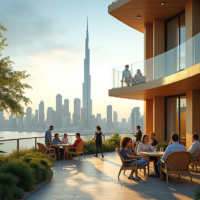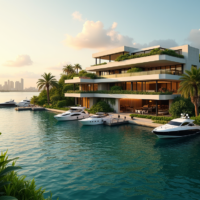The quest for affordable housing remains a significant concern for many, as residential areas experience changes in demographics, economy, and availability. The main topic of this article is to guide readers through the various types of affordable residential communities available, comparing their benefits and amenities. We’ll explore the range of residential options designed to cater to different needs and budgets, including affordable apartments, the most affordable residential environments, and comprehensive housing communities that balance cost with quality living.
The Rise of Affordable Housing Communities
In the ever-evolving landscape of urban living, housing communities dedicated to affordability are gaining traction. These communities offer a breath of fresh air to those being priced out of traditional markets. A residential community focused on affordable housing often combines several housing types, typically ranging from single-family dwellings to multifamily complexes such as townhomes and apartments. Community featuring amenities like parks, community centers, and easy access to public transportation, are also having a significant impact on overall livability and attractiveness for potential residents.

Types of Affordable Residential Areas
When considering a move to an affordable residential area, one must understand the spectrum of available options. Here are two primary categories:
- Traditional Residential Developments: These are typically suburban neighborhoods with standalone homes. While not always the most affordable, developers are increasingly including sections of lower-cost homes to accommodate diverse economic backgrounds.
- Planned Residential Communities: These areas are carefully designed with a mixture of housing types, often including both rentals and ownership opportunities. They also offer community amenities like recreational facilities and retail spaces, designed to create an inclusive environment.
Residential options come in various forms, and while stand-alone houses might still prevail in common imaginations, there’s a growing trend towards multi-use complexes and high-density living. Affordable apartments, especially those part of larger residential developments, provide an alternative for those seeking lower-cost living without compromising on amenities.
Advantages of Choosing an Affordable Residential Community
Living in an affordable residential community doesn’t just mean cutting costs—it also offers a range of benefits that enhance residents’ quality of life. Here are a few:
- Community Support and Resources: Many affordable residential communities come with a variety of programs and resources designed to support residents, like job training, education programs, and communal events.
- Shared Amenities: These communities often feature shared facilities such as swimming pools, fitness centers, and green spaces, fostering a sense of community and wellbeing amongst residents.
Affordable residential areas are not a one-size-fits-all solution, but there are numerous options for individuals and families to consider. The following table showcases a comparative overview of different residential options, illustrating the diversity within affordable living arrangements.
| Residential Type | Ownership | Amenities | Best for |
|---|---|---|---|
| Standalone Homes | Owned or Rented | Varies Greatly | Families seeking privacy and space |
| Apartment Complexes | Rented | High | Individuals or small families prioritizing community and convenience |
| Co-Op Housing | Shared Ownership | Moderate | Those looking for a collaborative living environment |
| Townhouses | Owned or Rented | Moderate | Small families or couples looking for a balance between apartments and standalone homes |
| Manufactured Homes | Owned or Rented | Varies | Those in need of an economical alternative to traditional housing |
Evaluating Cost vs. Quality in Affordable Apartments
When assessing affordable apartments, cost and quality often walk a fine line. Prospective renters must judge the value of an apartment not just by its rent, but also by considering the overall living experience it provides. Affordable apartments can vary greatly in terms of layout, location, and included utilities, making thorough research and comparison crucial. Moreover, complexes may offer attractive incentives such as reduced rent for the initial lease term or included amenities like internet and cable. It is important, however, to read the fine print and understand what is and isn’t included in the “”affordable”” price to avoid unexpected costs.

The Importance of Community Features
Residential options that prioritize community features significantly enhance the living experience for residents. A housing community that encourages interaction through shared spaces and regular activities helps in nurturing a strong, supportive neighborhood. It is worth noting the rise of mixed-use developments that combine residential living with retail, dining, and entertainment options all within walking distance. These all-encompassing environments not only cater to convenience but also foster a vibrant, interactive community. Furthermore, eco-friendly features and sustainability initiatives are becoming increasingly important in residential areas, appealing to environmentally conscious residents and contributing to long-term affordability through energy savings.
How Residential Developments Connect with Broader Infrastructure
The placement of residential developments within the larger context of city infrastructure cannot be overlooked. Proximity to public transportation, healthcare facilities, schools, and employment centers makes a residential community more appealing and practical. Here, we can consider two pivotal aspects:
- Accessibility: Well-connected residential developments ensure that residents can easily commute to their workplaces or educational institutions, reducing transportation costs and saving time.
- Urban Planning: Thoughtfully designed residential areas also take into account longer-term urban planning, integrating with future developments and contributing to sustainable growth.
The best affordable housing communities are those that offer more than just a place to live; they provide a platform for a well-rounded lifestyle. It is essential to consider the interplay between the residential community and its surrounding infrastructure during the selection process.

Conclusion
In conclusion, affordable residential communities are diverse and can accommodate a wide range of preferences and needs. Whether it’s a stand-alone home in a suburban enclave, an affordable apartment in a bustling city, or a unit in a cooperative housing project, the options are many. It is essential to weigh the advantages and consider the long-term implications of any choice. With careful consideration and the right information, you can find a living space that is both affordable and conducive to a fulfilling lifestyle.
FAQ:
Q: What should I look for when searching for an affordable residential community?
A: When searching for an affordable residential community, consider factors such as the cost of rent or mortgage, included amenities, location, accessibility to transportation, schools, and workplaces, the quality of housing, community features, and whether the environment aligns with your lifestyle needs. Investigate any additional fees or services that may affect your budget.
Q: How do I know if an apartment is genuinely affordable?
A: To determine if an apartment is genuinely affordable, calculate the total cost of living, including rent, utilities, transportation, groceries, and any other recurrent expenses. Ensure these costs do not exceed 30-40% of your monthly income, which is the general guideline for affordability. Additionally, research the market to compare prices and verify if the apartment’s rent is in line with similar properties in the area.
Q: Are there particular advantages to living in a planned residential community?
A: Yes, living in a planned residential community comes with several advantages:
- Designed with intentionality, these communities often feature a cohesive look and feel.
- They typically offer a variety of amenities such as parks, playgrounds, sports facilities, and sometimes even schools and shopping centers, promoting convenience and a higher quality of life.
- The layout is usually optimized for traffic flow and pedestrian safety.
- Many have homeowners’ associations (HOAs) that maintain community standards and handle common area maintenance.
- They often foster a strong sense of community, organizing events and activities for residents.
Q: Can I find affordable housing in urban areas?
A: Yes, affordable housing can be found in urban areas, though it may require more persistence due to higher demand. Look for government-subsidized housing programs, housing cooperatives, and newer developments that include affordable units to comply with local housing regulations. Also, consider neighborhoods that are up-and-coming, as they may offer lower rent while still providing access to urban amenities.









